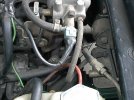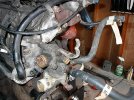Hey fellas-- happy July!
I'm still dealing with the nagging poor running problem and occasional stalling that has been going on for the last few years, and it's keeping me from driving the car very much.
I have a staycation next week, and time to work on this, so I want to get to the bottom of it once and for all.
From cold, the car starts right up and purrs like a kitten. After a few minutes of running, as things start to come up to temperature, it will begin to buck and want to stall. I've tested the injectors, the coil has been replaced, and otherwise everything seems tip top.
Today, as I was playing with one of my old cars with a mechanical choke, I forgot to turn the choke off, and that car began to act exactly like the X as it loaded up with fuel... and it got me to thinking-- is there any sort of electronic choke or cold start valve that might be failing/have failed on my X? I took a quick look in the FSM, and I didn't see anything, so I'm hoping one of you guys might know.
I'm also open to any other ideas you might have.
I'm still dealing with the nagging poor running problem and occasional stalling that has been going on for the last few years, and it's keeping me from driving the car very much.
I have a staycation next week, and time to work on this, so I want to get to the bottom of it once and for all.
From cold, the car starts right up and purrs like a kitten. After a few minutes of running, as things start to come up to temperature, it will begin to buck and want to stall. I've tested the injectors, the coil has been replaced, and otherwise everything seems tip top.
Today, as I was playing with one of my old cars with a mechanical choke, I forgot to turn the choke off, and that car began to act exactly like the X as it loaded up with fuel... and it got me to thinking-- is there any sort of electronic choke or cold start valve that might be failing/have failed on my X? I took a quick look in the FSM, and I didn't see anything, so I'm hoping one of you guys might know.
I'm also open to any other ideas you might have.



